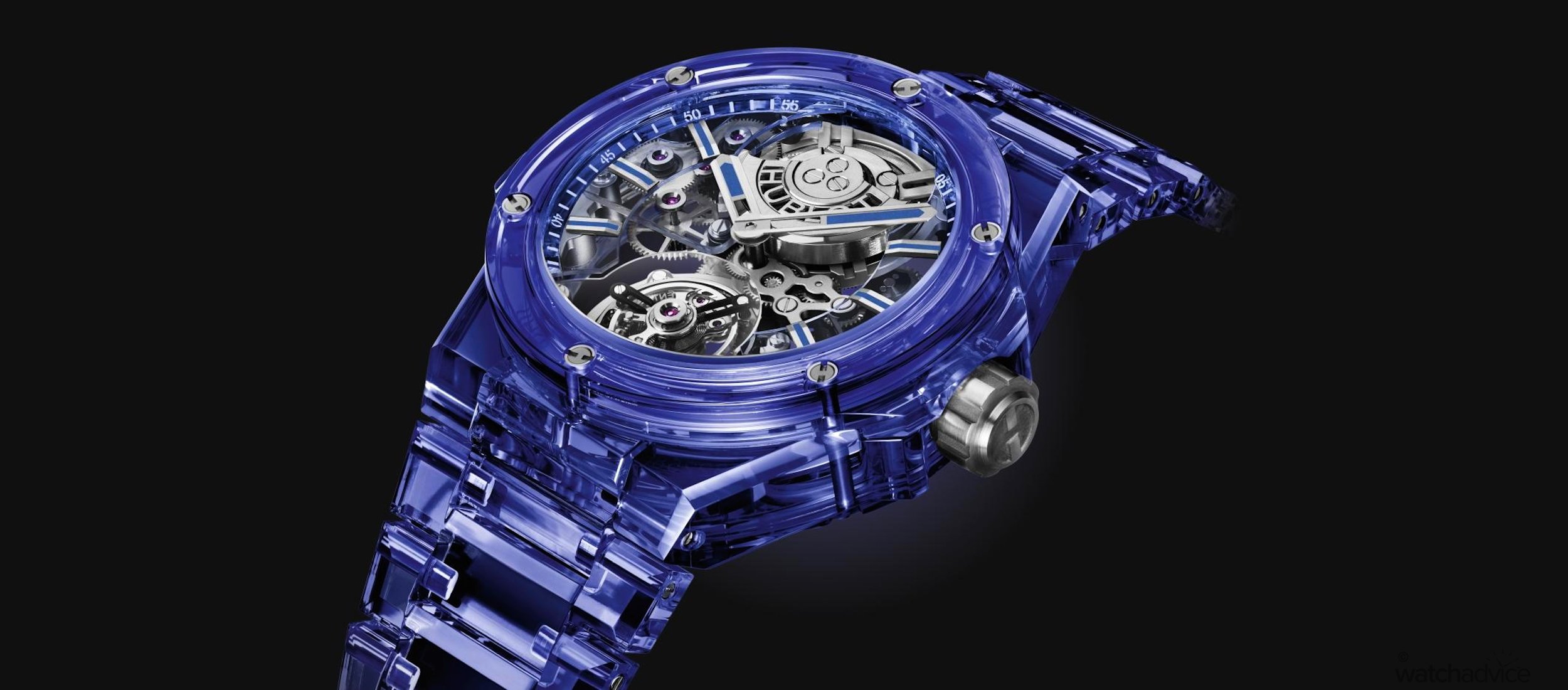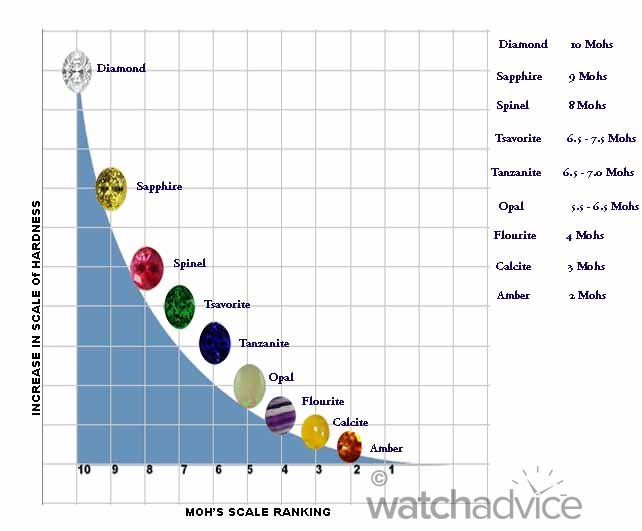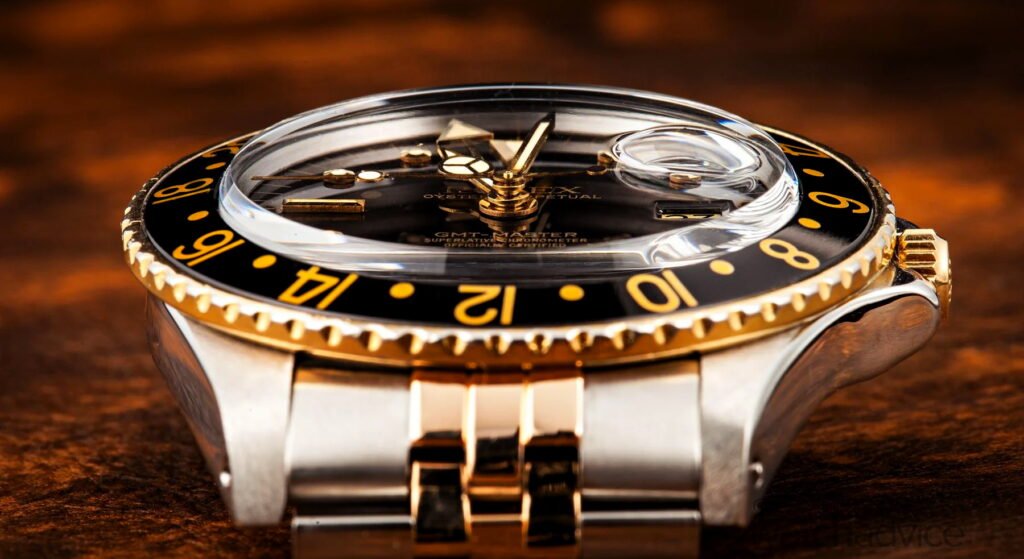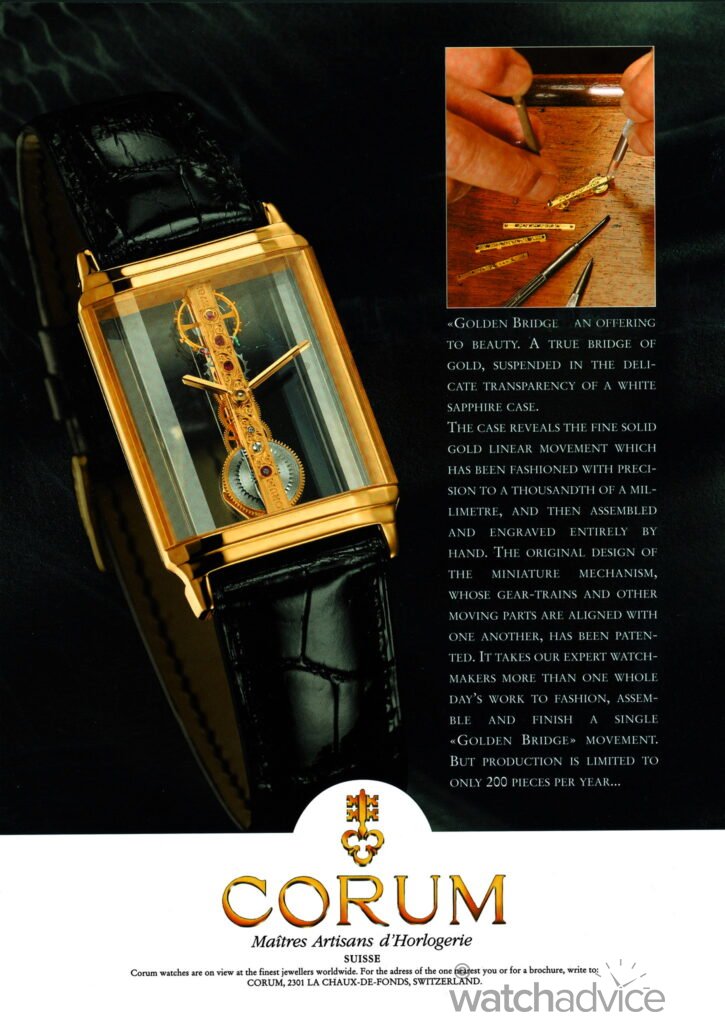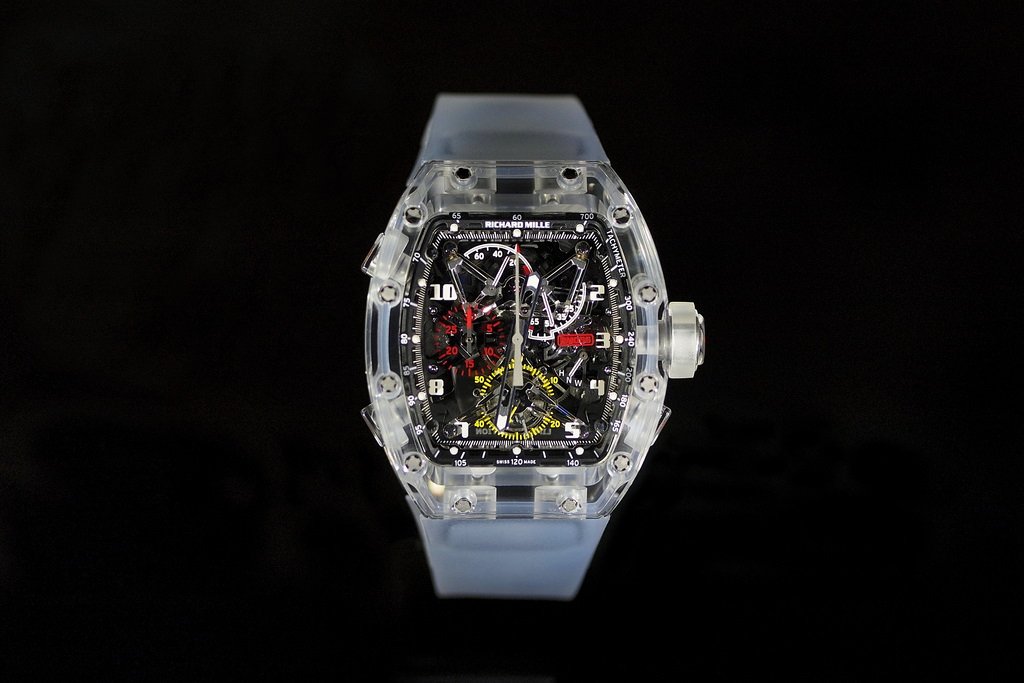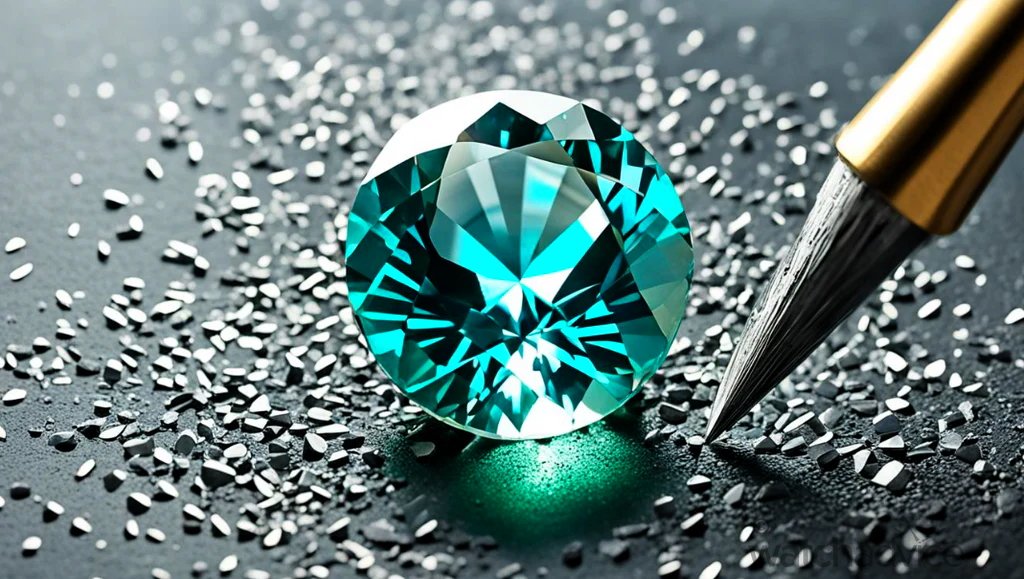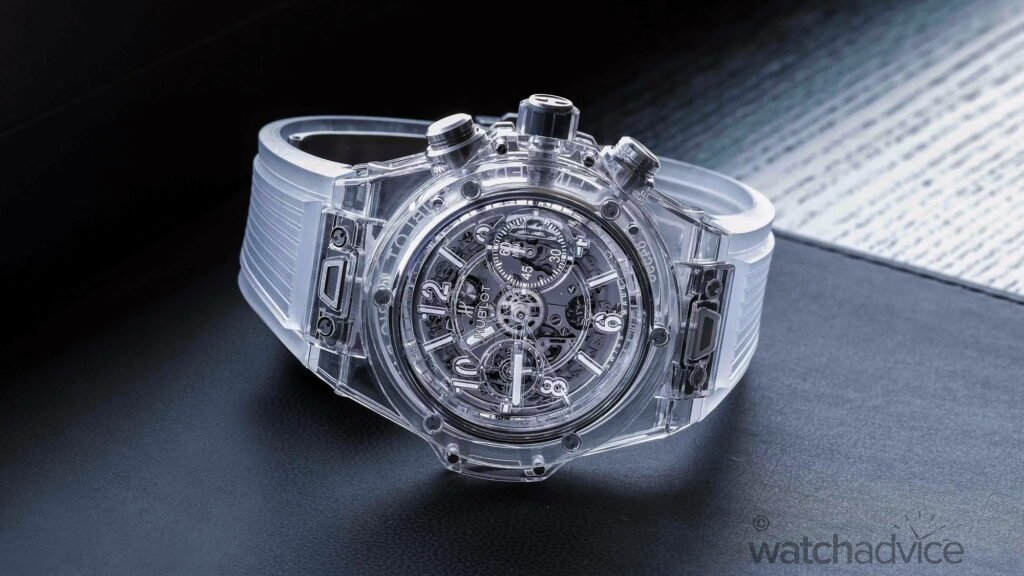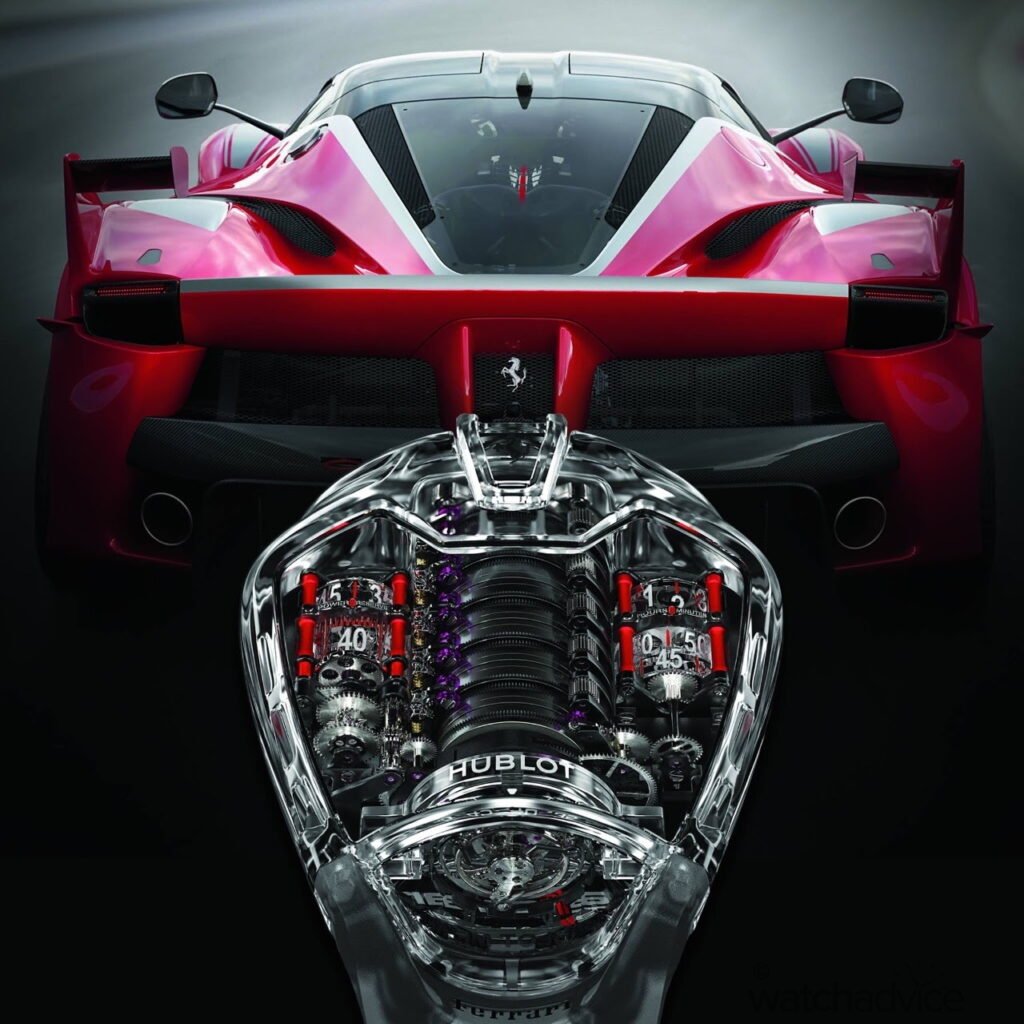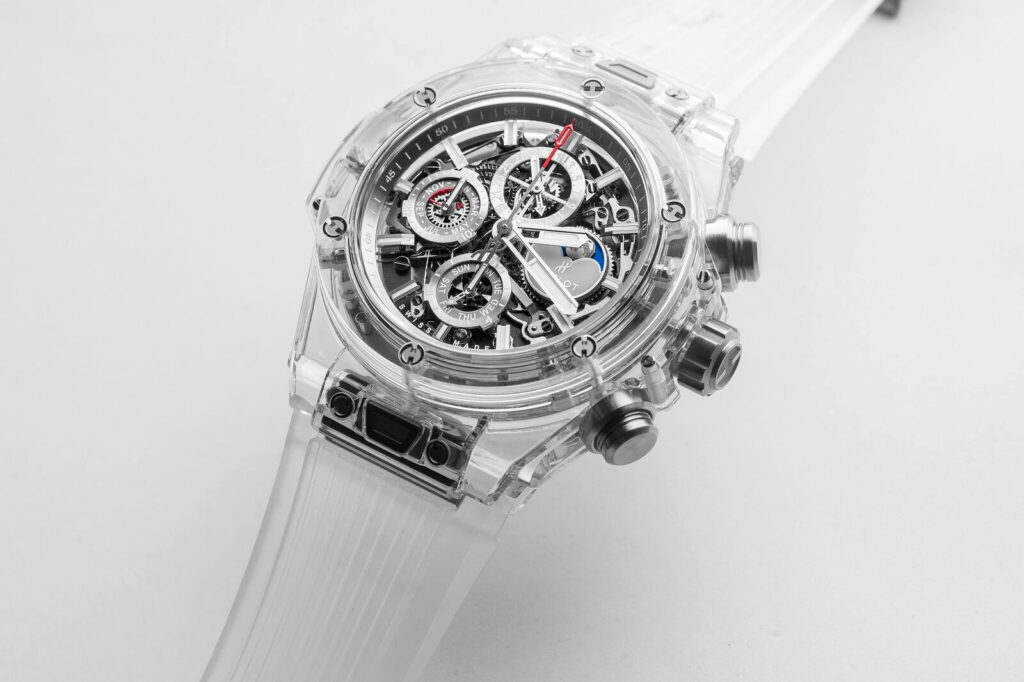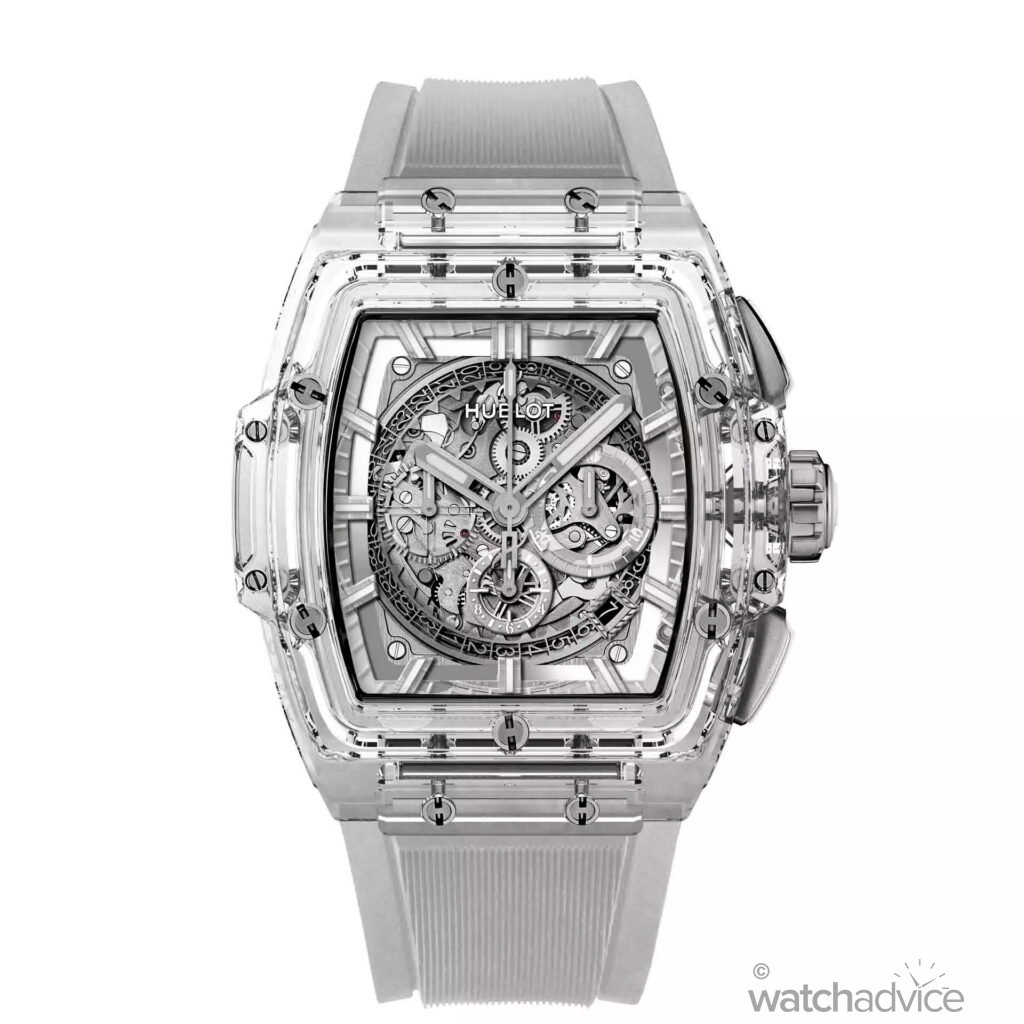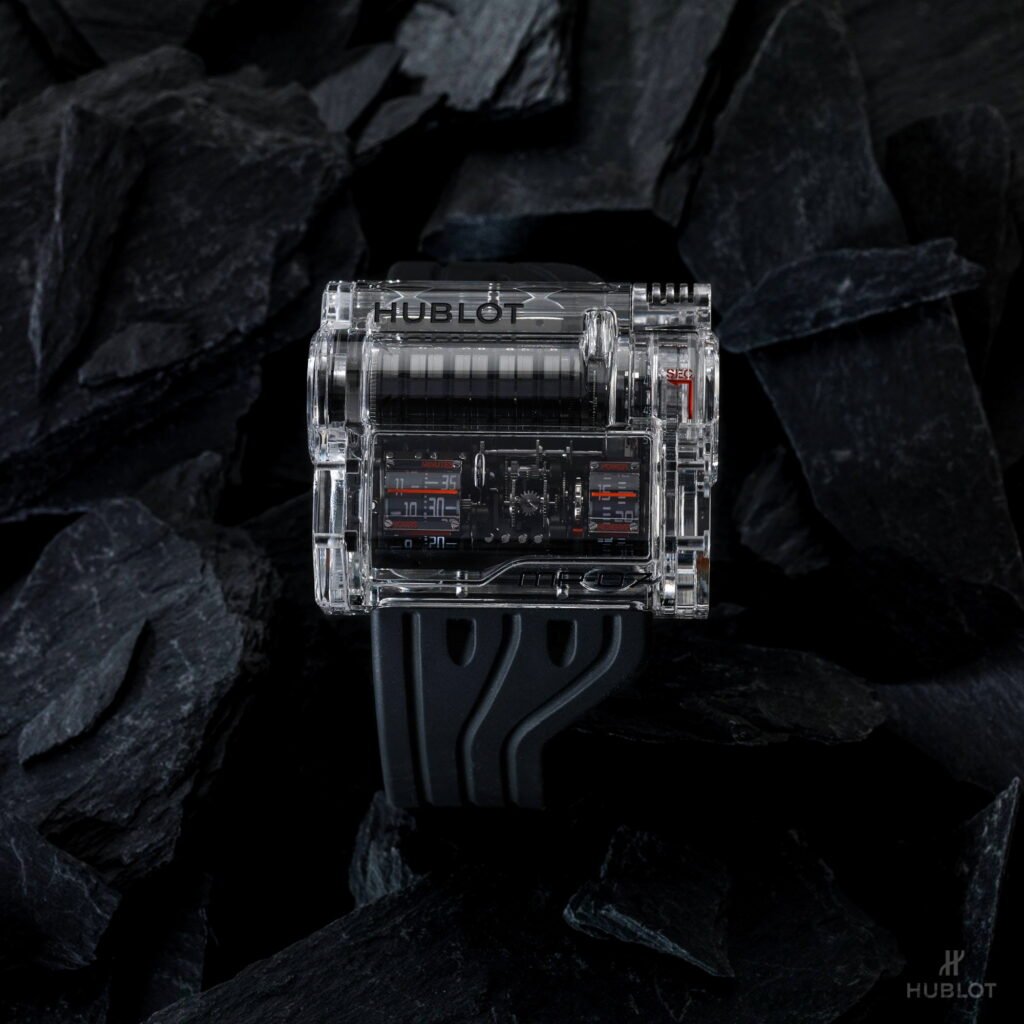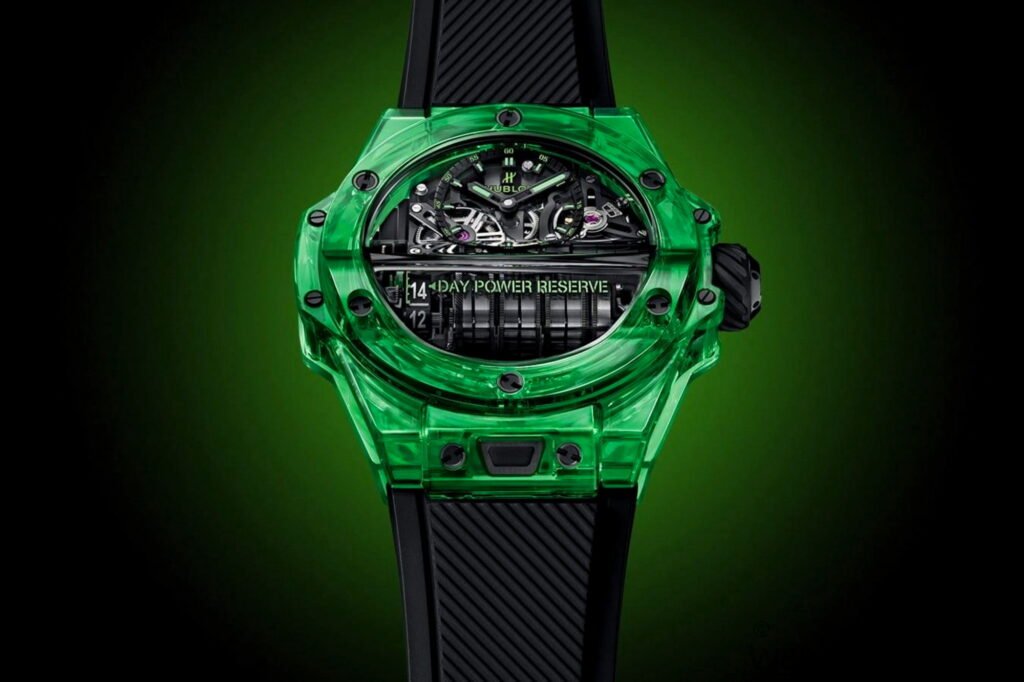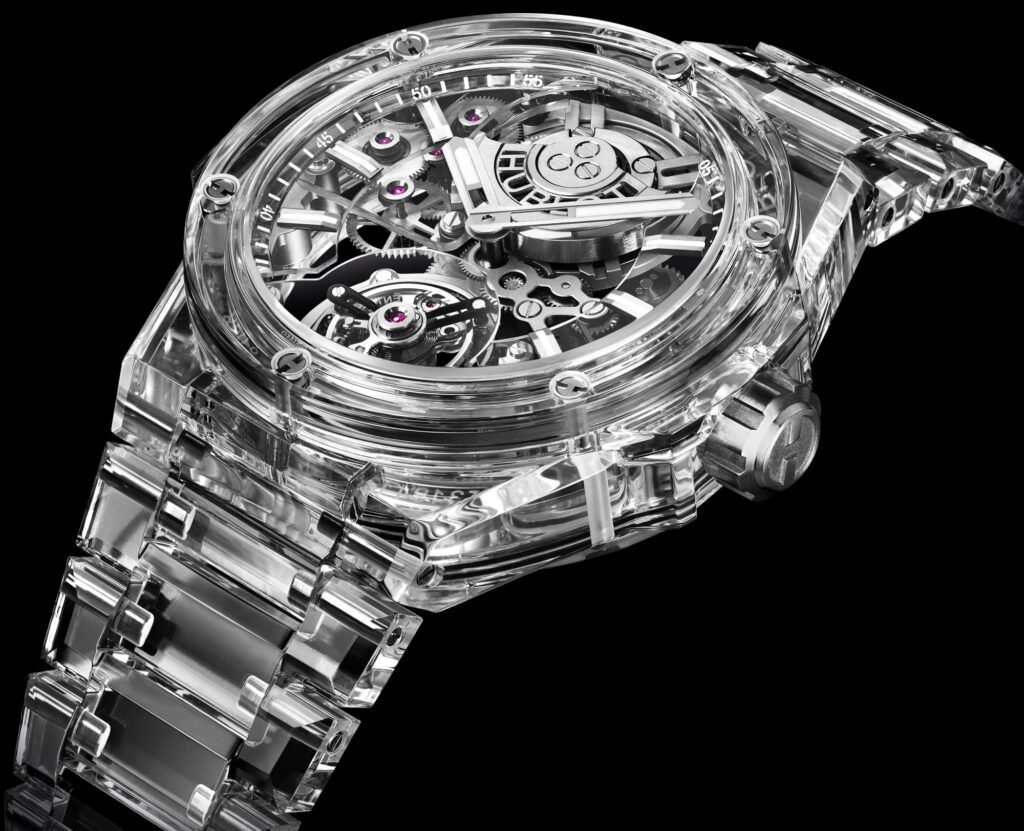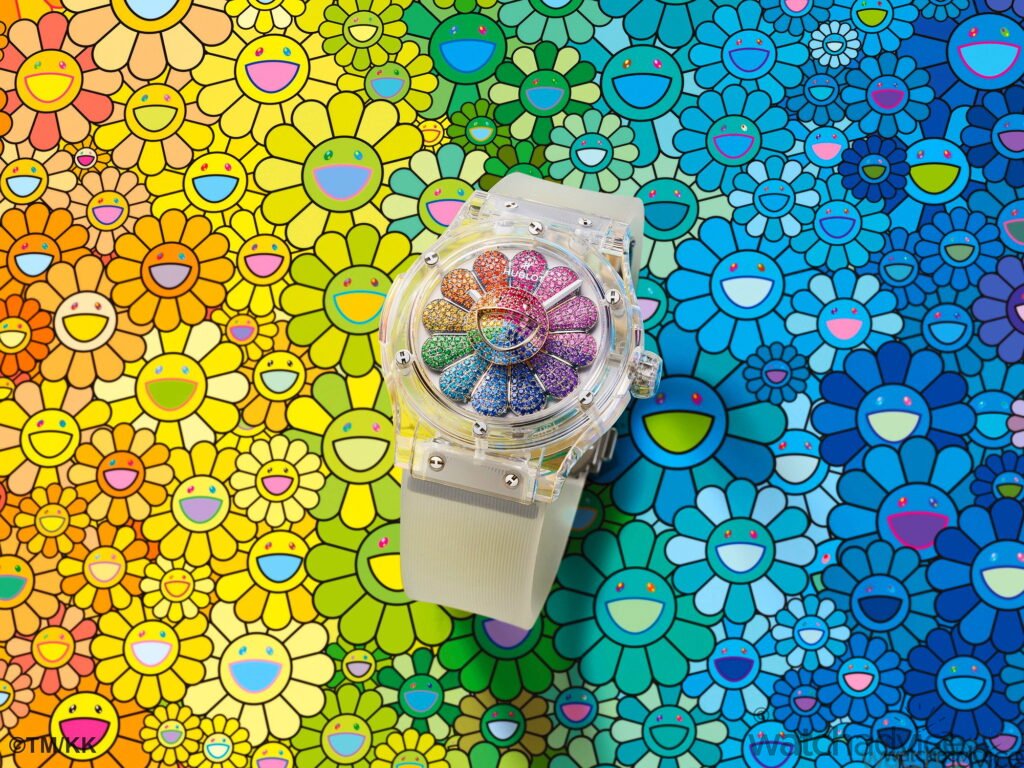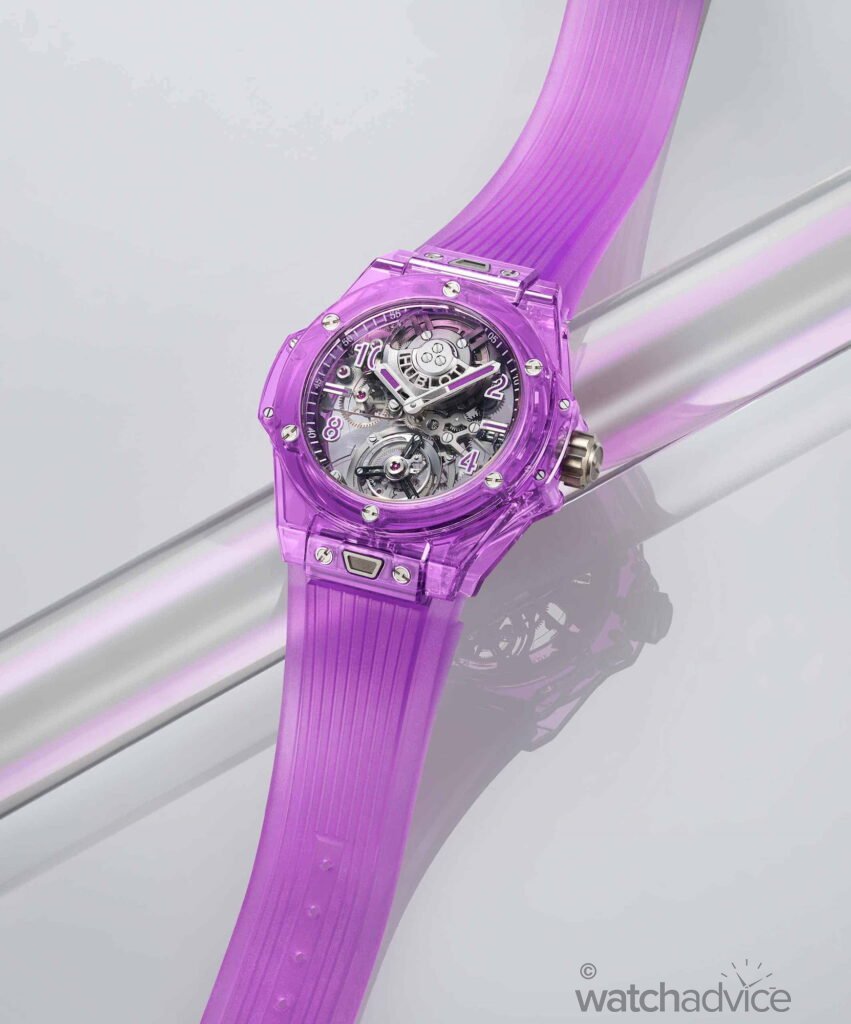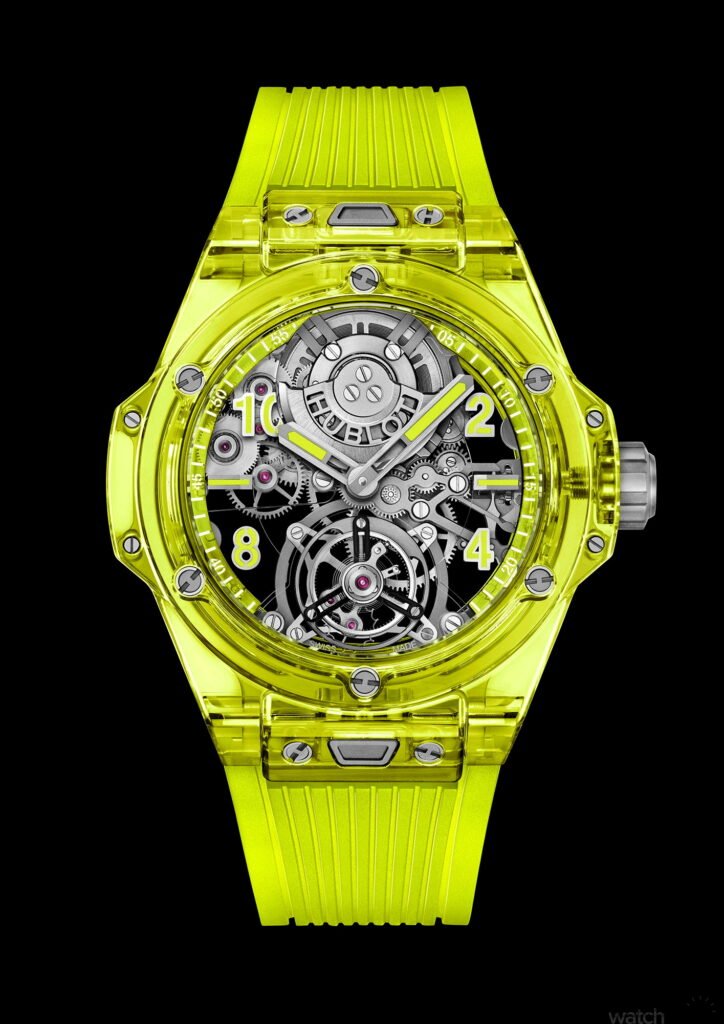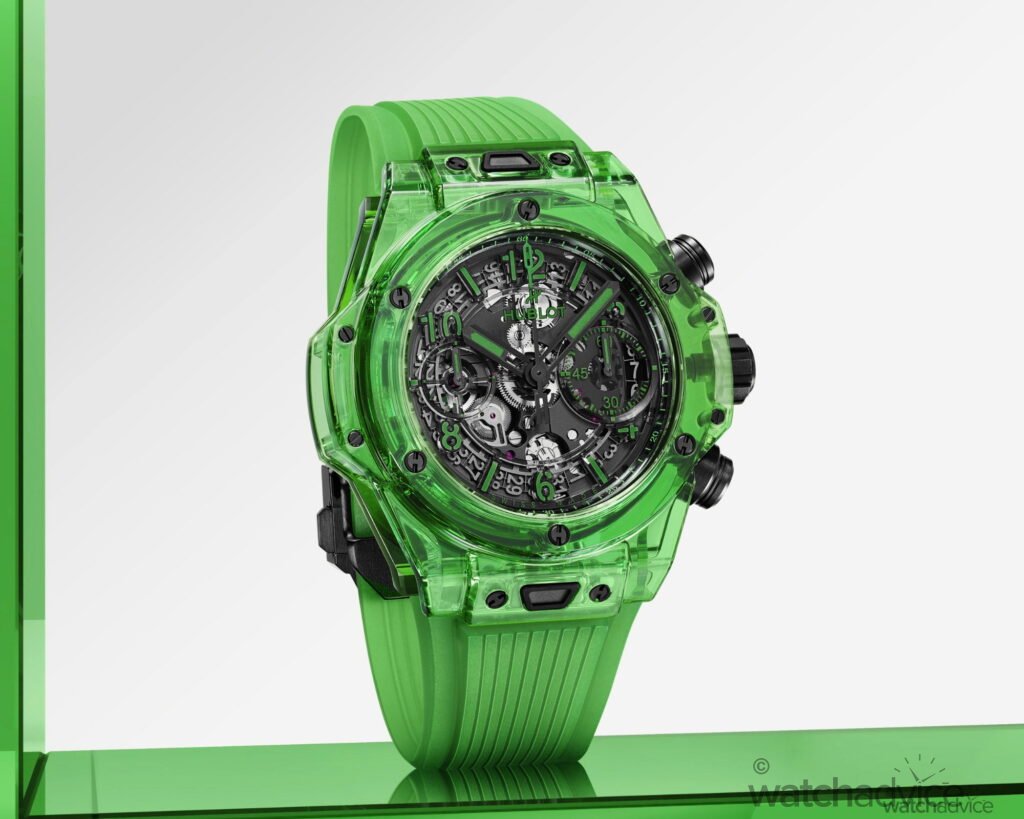Innovation isn’t always comfortable, but Hublot’s sapphire pieces are unapologetically exceptional.
Watchmaking innovation often involves a deep respect for traditional craftsmanship while pursuing groundbreaking ideas. Few watch brands in the world of horology today personify this balancing act as boldly as Hublot. The brand is known for its avant-garde designs and material choices, allowing it to carve out a niche in the watch industry that is as polarizing as it is groundbreaking.
What I personally like about Hublot is their willingness to push the envelope. It is not purely about aesthetics or mechanical sense, but also about bringing something entirely different to the industry. In a world where many brands like to play it safe, sticking to the tried-and-true, watchmakers like Hublot are a much-needed source of creativity and daring spirit.
Hublot has become somewhat of a love-or-hate brand, and a lot of the time it’s formed by un-informed opinions. Matt covers this in great detail in his article about the misconceptions of Hublot, and it is true how when you go on social media, a lot of the negativity comes from people listening to influencers or celebrities that want to make “clickbait” worthy headlines or topics of discussion because it is the trend at the moment. It’s even worse then when the uninformed comment without doing research or educating themselves, i.e following the “herd”.
RELATED READING: Is Hublot The Most Misunderstood Brand In The Industry?
While no brand is perfect, and everyone has flaws, certain brands out there don’t come close to Hublot’s innovation and future-thinking, and yet they are recognised much more positively due to having more popularity and a cult following. And I get it; you still need traditional designs and watches with classic styling, but it shouldn’t mean that we dismiss brands that are on the other-end of the spectrum who try to create truly unique pieces.
Hublot’s designs will not cater to everyone’s tastes, and that is precisely the point. Hublot thrives on challenging conventions, appealing to those who “dare to embrace the extraordinary.” One of the boldest examples of the brand’s daring spirit is its sapphire creations. By taking a material traditionally reserved for protective crystals and transforming it into an integral part of the watch (case, dial, bracelet), Hublot has redefined the boundaries of what luxury watches can look like.
“We bring our dreams to life by creating new materials. At the forefront of innovation. At the forefront of creation.”
Hublot
Introduced by Jean-Claude Biver when he revitalised the brand in the early 2000s, Hublot’s “Art of Fusion” is a philosophy that is the brand’s guiding principle. This philosophy is the idea of bringing together traditional watchmaking craftsmanship with innovative materials and modern/futuristic/artistic designs. Hublot states, “To achieve its “Art of Fusion,” the Manufacture has its own Metallurgy and Materials laboratory, working in close collaboration with the Research and Development department, as well as its own foundry. These innovative materials are created and manufactured using the latest technologies, unique in watchmaking and developed by Hublot”.
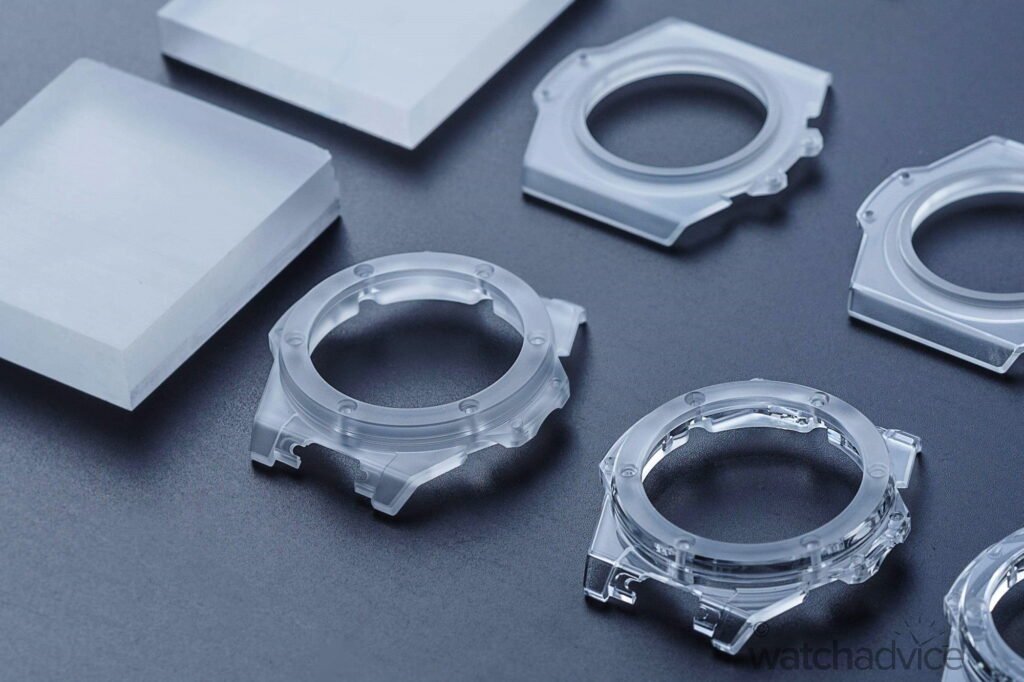
The Hublot engineers and chemists, in search of the perfect fusion between movement and case, have researched and developed a transparent material that shows the heart of the timepiece. This transparent material was also created to be robust enough to protect the movement sitting inside. Through the research and development from the manufacturer’s Metallurgy and Materials laboratory, the brand has quickly become an expert in synthetic sapphire.
What is Sapphire?
To comprehend how watchmakers like Hublot use sapphire in their timepieces, we first need to gain an understanding of what this material is. Simply put, sapphire is a crystalline form of aluminium oxide (AI203) known as corundum. Sapphires are found naturally, formed deep within the Earth’s crust over millions of years when aluminium and oxygen atoms combine under intense heat and pressure. This resulting process creates metamorphic rocks, which sapphires can be found inside of. Due to the complex geological processes that are involved in the creation, sapphires are extremely rare gemstones. Through its natural creation, sapphires can be found in many different colours, including pink, purple, green, orange, teal, yellow, peach, white and blue
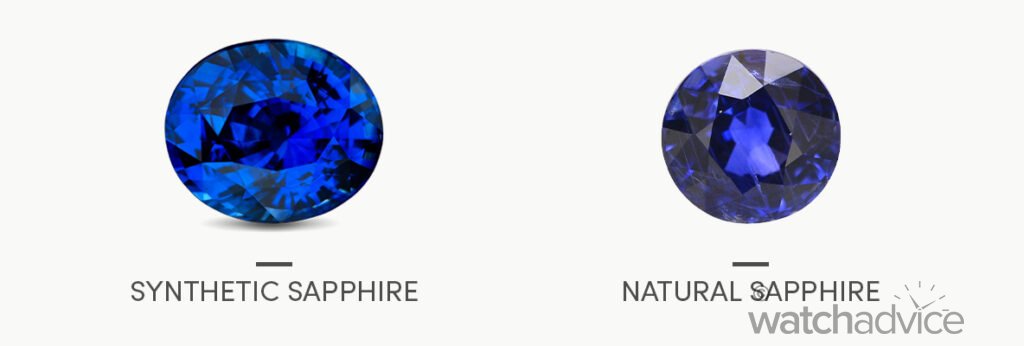
Sapphires can of course also be made synthetically. By artificially creating sapphires, manufacturers can save a lot of time and money rather than sourcing natural stones. These are just the surface-level benefits. The more appealing side to synthetic sapphires is that you can create whatever shape or size is required for the design.
Gemsociety states that “There are two types of methods for artificially creating sapphires: melt processes, which involve melting aluminium oxide into a sapphire droplet, and solution processes, which grow sapphire crystals in a solution.” Also known as the Verneuil method, the “melting process” The most inexpensive and oldest melt process is known as flame fusion. In this method, a flame melts aluminium oxide powder (the principal mineral in corundum). The drops form into a long teardrop shape called a “boule.” The addition of other minerals to the aluminium oxide can create coloured varieties of sapphire.
Why use Sapphire In Watchmaking? The Material’s Unique Appeal
Sapphire has long been valued for its hardness and optical clarity. Its aesthetics allow it to be see-through (if transparent), while different colours of sapphire offer visuals that no other material can. This optical clarity of the material enhances the visibility of the dial and its movement, which makes it a great material when considering case design.
Sapphire’s properties also make it invaluable, especially in watchmaking. Sapphire ranks nine on the Mohs hardness scale, making it highly resistant to scratches. To put it into perspective, aluminium ranks around 2.75, steel ranks around 4.5, and titanium ranks six on the Mohs hardness scale. This makes sapphire considerably stronger than traditional watchmaking materials; however, of course, the downside is the accessibility to the material and high production costs.
Evolution of Sapphire in Watchmaking
Rolex – Pioneer of Integrating Sapphire Into Watchmaking
Although Jaeger-LeCoultre and Omega were some of the first to use synthetic sapphire on watch crystals, Rolex was one of the first brands to fully adopt synthetic sapphire into their watchmaking, starting with the watch crystals. It began in the 1970s when Rolex started replacing the acrylic glass with sapphire crystals to enhance durability and scratch resistance. With the material mentioned above properties of sapphire, it made for the perfect material to not only be able to see through very clearly but also have the strength to protect the dial from shocks, scratches, and hits.
Corum – Pushing the Boundaries of Transparency
After Rolex integrated sapphire, Corum was another early adopter of the sapphire material. Corum was one of the first brands to experiment with sapphire in innovative ways. In the 1980s, the luxury Swiss watchmaker started to experiment with sapphire material. Corum released the “Golden Bridge” timepiece. What made this watch stand out was the fact that it was fully visible. The timepiece features a sapphire crystal case back, which allows the wearer to see through the watch entirely. The Golden Bridge timepiece featured a fully visible baguette-shaped movement framed by a sapphire crystal. This can also be seen as the first time a brand has used sapphire in the watch case “construction”.
Richard Mille – Revolutionising Sapphire Case Making
Although not the first to create a sapphire watch case, Richard Mille was the first brand to truly revolutionise sapphire case making in the 21st century. The brand’s release of the RM 056-01 in 2012 was extraordinary. It was the first time the world of horology saw a fully sapphire timepiece featuring movement complications. Due to the complexity of creating a sapphire watch case, it took approximately 1000 hours of machining, forming, and polishing sapphire case components to create this masterpiece.
Hublot – Taking Sapphire Creations To New Heights
Richard Millie’s RM056 puts into perspective just how difficult it is to create a sapphire timepiece. Before Hublot began their Sapphire journey, they learnt the processes and techniques required for watchmaking and built an in-house manufacturing laboratory to experiment, design and create sapphire timepieces.
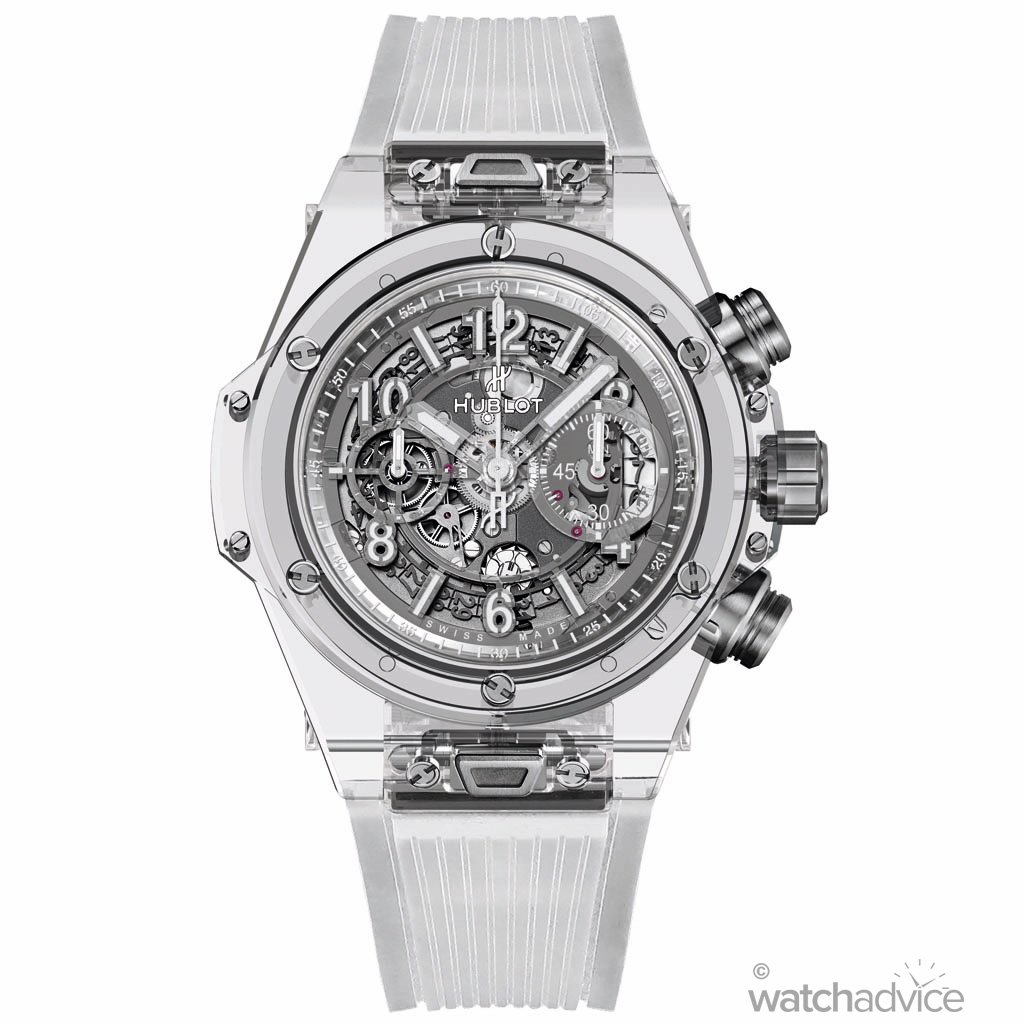
Hublot’s first fully sapphire case came in 2016, when the brand introduced the Big Bang Unico Sapphire. The timepiece showcased the entire movement inside the transparent case, and just like the RM056, it brought new light into the world of watchmaking.
The brand then took the world of sapphire creations by storm by making them accessible, this time in colour. They were the brand to pioneer the use of vibrant colours in sapphire watchmaking, by introducing colours such as purple, red, blue, yellow and orange. This solidified Hublot’s position as the leader in sapphire innovation!
Challenges and Triumphs of Hublot Using Sapphire Material
As mentioned previously, creating synthetic sapphire is certainly no easy task. Richard Mille taking 1000 hours to create and perfect their full sapphire case timepiece with the RM061 puts into perspective how challenging the task really is. This makes it all the more impressive that Hublot has nailed down this process not only to make it more efficient but also to create watches that are sustainable and cost-effective so that they are still somewhat attainable, with the lowest-priced sapphire watch being the clear transparent Unico Sapphire 42mm fetching for $107,000 AUD currently.
To get to this point, however, Hublot had to face some incredibly hard challenges. When I had the chance to visit the Hublot Manufacture in Switzerland this year, I spent quite a bit of time understanding their material processes, especially sapphire, as that was what intrigued me the most.
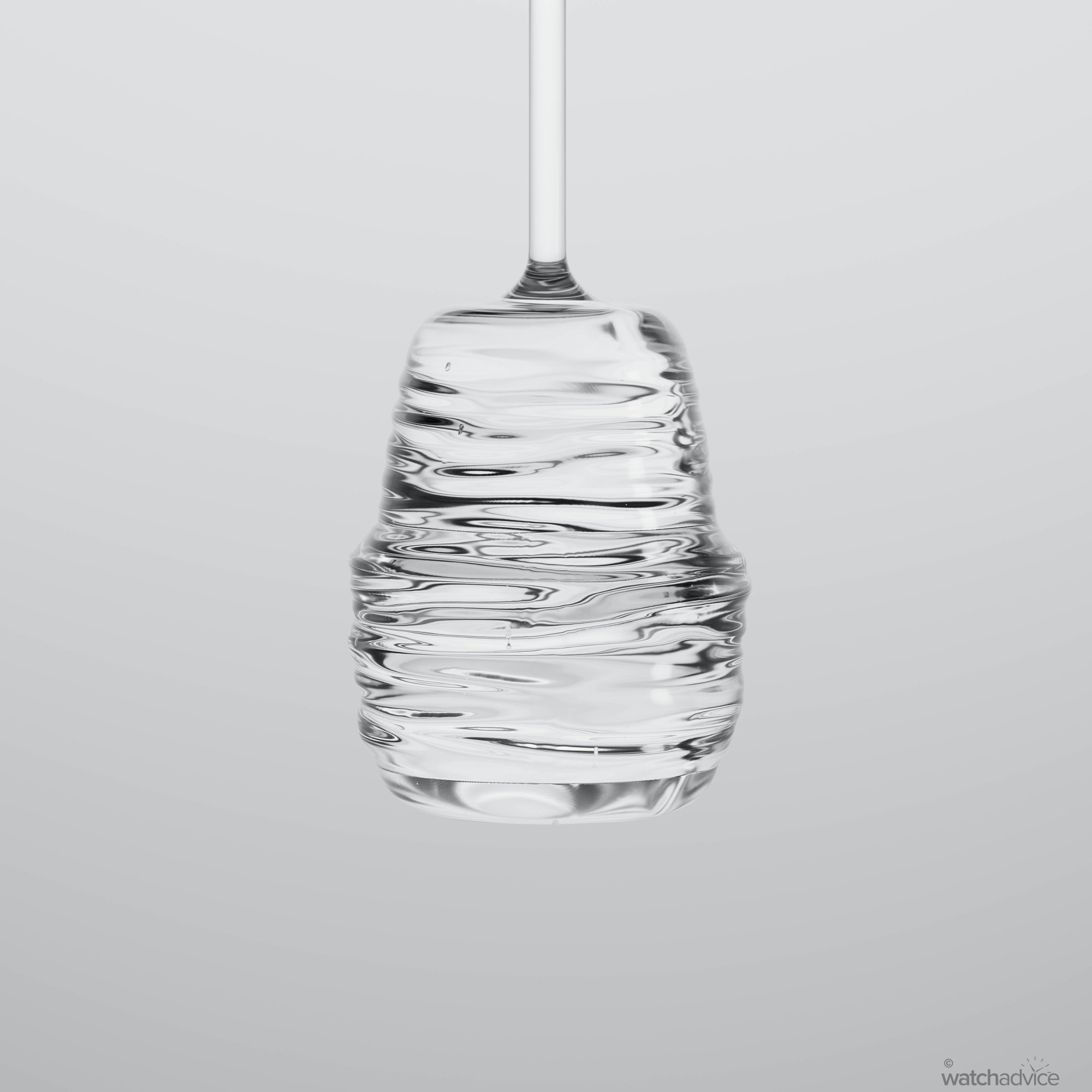
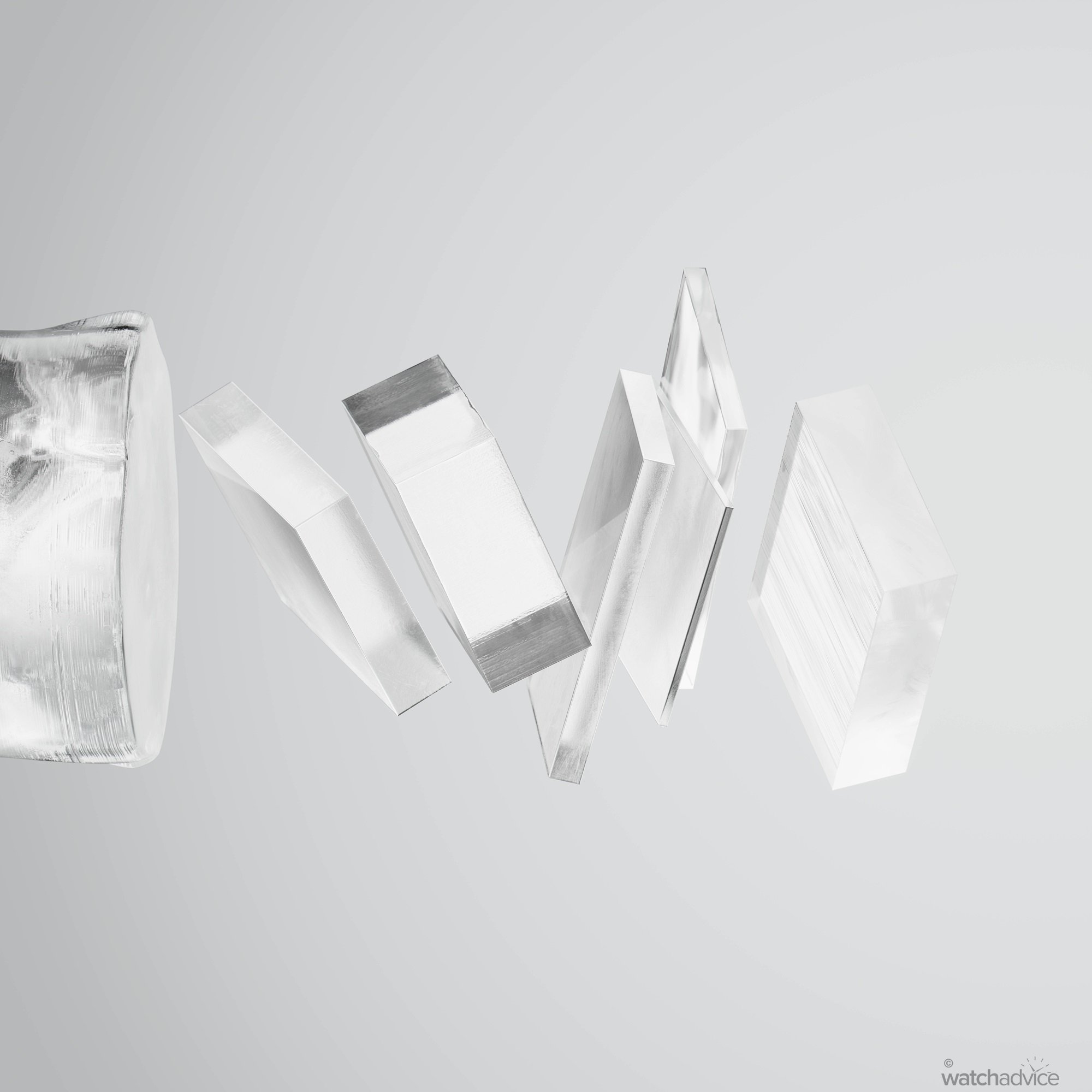
Hublot’s process of creating Sapphire is like the Kyropoulus method, whereby pure aluminium oxide is melted and crystallised into large sapphire ingots (see picture above). The engineers and scientists then create cylindrical tubes within the ingot. These “tube” cut-outs are then meticulously cut, shaped, and polished into the required components of the watch. This is, of course, the simplest way of explaining the process. The difficulties lie in that, firstly, if there are impurities in the ingot itself (wrong temperatures in the crystallisation process), the whole process must be repeated to create a new sapphire ingot.
The next difficulty lies in machining the sapphire material to the required shape. Due to its hardness, sapphire is incredibly difficult to cut and shape. Sapphire can only be cut by one material, which is diamond, the hardest known material on earth. Specialised tools such as diamond-tipped cutters are used to cut sapphire into the required shapes.
While most watchmakers face these obstacles when trying to make sapphire timepieces, Hublot’s breakthrough of creating coloured sapphire watches sets them apart as industry leaders in this space.
Hublot was the first brand to introduce coloured sapphire cases at a production scale. The brand states that “In 2017, the watchmaker pushed the limits even further: the master of the Art of Fusion accomplished the feat of creating large coloured sapphires, despite the complexity, unpredictability, instability and lack of homogeneity in the fusion and crystallisation of sapphire. This innovation and mastery are backed both by significant investments, which have facilitated the industrialisation of sapphire, and by the work of the internal R&D team, which is continuously exploring how to create new colours of sapphire.”



To create the different coloured cases, different metallic oxides must be added during the crystallisation process to produce vibrant colours. For example, to make red sapphire (ruby), you must add chromium into the mix; to get blue sapphire, cobalt is needed; and to get yellow sapphire, copper is required. When the Hublot Spirit of Big Bang Yellow Sapphire was released, it was the first time in the history of watchmaking that sapphire had been coloured yellow.
The challenge of creating coloured sapphires as Hublot explained above, lies in precisely controlling the type and amount of (chromium, cobalt, copper etc) that’s added to the mix during the crystallisation process. Even an extremely minor deviation can lead to an uneven coloration or impurities in the sapphire. The uneven colouration means that no two sapphire timepieces of the same colour will be the same, which is a major drawback.
Once the additives are added, they must then be uniformly distributed throughout the molten aluminium oxide. However, the high viscosity of the molten sapphire makes this process incredibly difficult. If there is even a tiny amount of uneven distribution, it will result in different colour gradients, streaks or blotches, which makes those sapphires used in Hublot timepieces not possible. To put it into a different perspective, creating small pieces of sapphire for, say, jewellery is by far much easier than what Hublot is achieving. This is because the larger the sapphire, the harder it is to achieve a consistent colour hue, as slight imperfections are shown much more prominent over a greater surface area.

While certain colours can be easier to work with when creating coloured sapphire timepieces, red sapphire (ruby) is thought as one of the hardest of the standard colours to create. This is because, as stated previously, to create a red sapphire, you must add chromium to the mix. Chromium interaction with aluminium oxide can lead to greater instability during the crystallisation process compared to other colours, which makes it incredibly difficult to make. Hublot, however, has mastered this process, which is how they were able to create timepieces like the Big Bang Unico Red Sapphire. This is a feat only very few brands in the world of horology can even come close to replicating.


To take things a step further, Hublot has not only mastered the “Art of Fusion” of creating sapphire watch cases, but they have also finessed the process of creating a full sapphire bracelet. There are only a handful of brands in the world today that have achieved what Hublot has created with full sapphire timepieces. If creating a coloured sapphire case was incredibly hard, I can’t begin to imagine what creating a complete sapphire timepiece would be like. Let alone on top of all of that, fitting in a fully skeletonised movement with a tourbillon complication. It’s no wonder a watch like the Big Bang Intergrated Tourbillon Full Blue Sapphire retails for approximately $820,000 AUD.
Hublot’s Key Sapphire Models
Hublot’s groundbreaking Big Bang Unico Sapphire, released in 2016, was the first watch to feature a fully transparent sapphire case. This timepiece set the stage for Hublot to go wild with future creations, creating not only new colours but also timepieces with high-complication and ones that would breathe new life into the world of horology.
2016 – Hublot Big Bang Unico Sapphire
Case size: 42mm
Sapphire Colour: Transparent
Movement: HUB 1242 UNICO
Reference: 411.JX.4802.RT
For More Information: Hublot.com.au
2016 – Hublot MP-05 LaFerrari
Case size: 58mm x 48mm x 16mm thick
Sapphire Colour: Transparent
Movement: Manual Wound MP-05
Reference: MP-05 LaFerrari Sapphire
2017 – Hublot Big Bang Unico Perpetual Calendar Sapphire
Case size: 45mm
Sapphire Colour: Transparent
Movement: Hublot Calibre HUB1270
Reference: 406.JX.0120.RT
2017 – Hublot Big Bang Unico Sapphire Rainbow
Case size: 45mm
Sapphire Colour: Transparent with multi-coloured gems on bezel.
Movement: Hublot Calibre HUB1242
Reference: 411.JX.4803.RT.4099
2017 – Hublot Big Bang Unico Red & Blue Sapphire
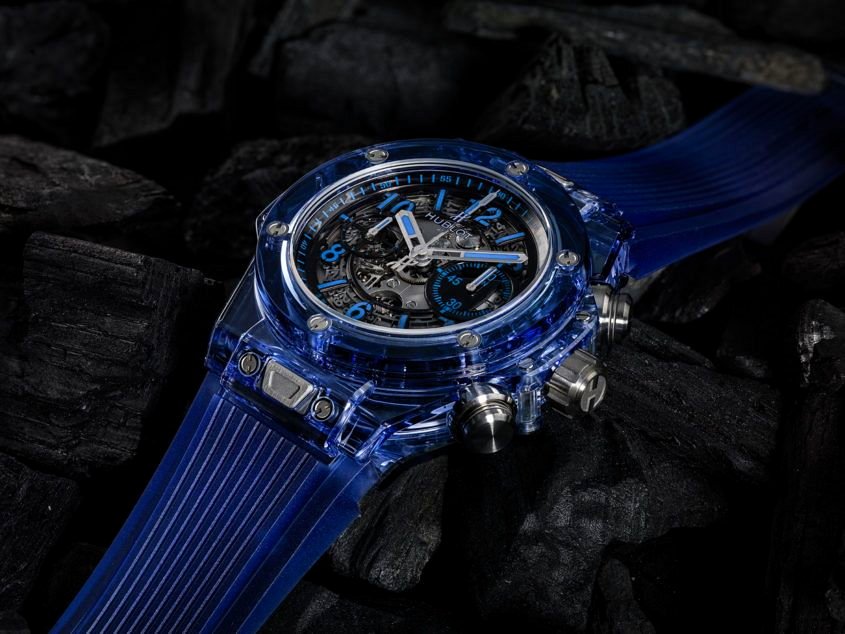
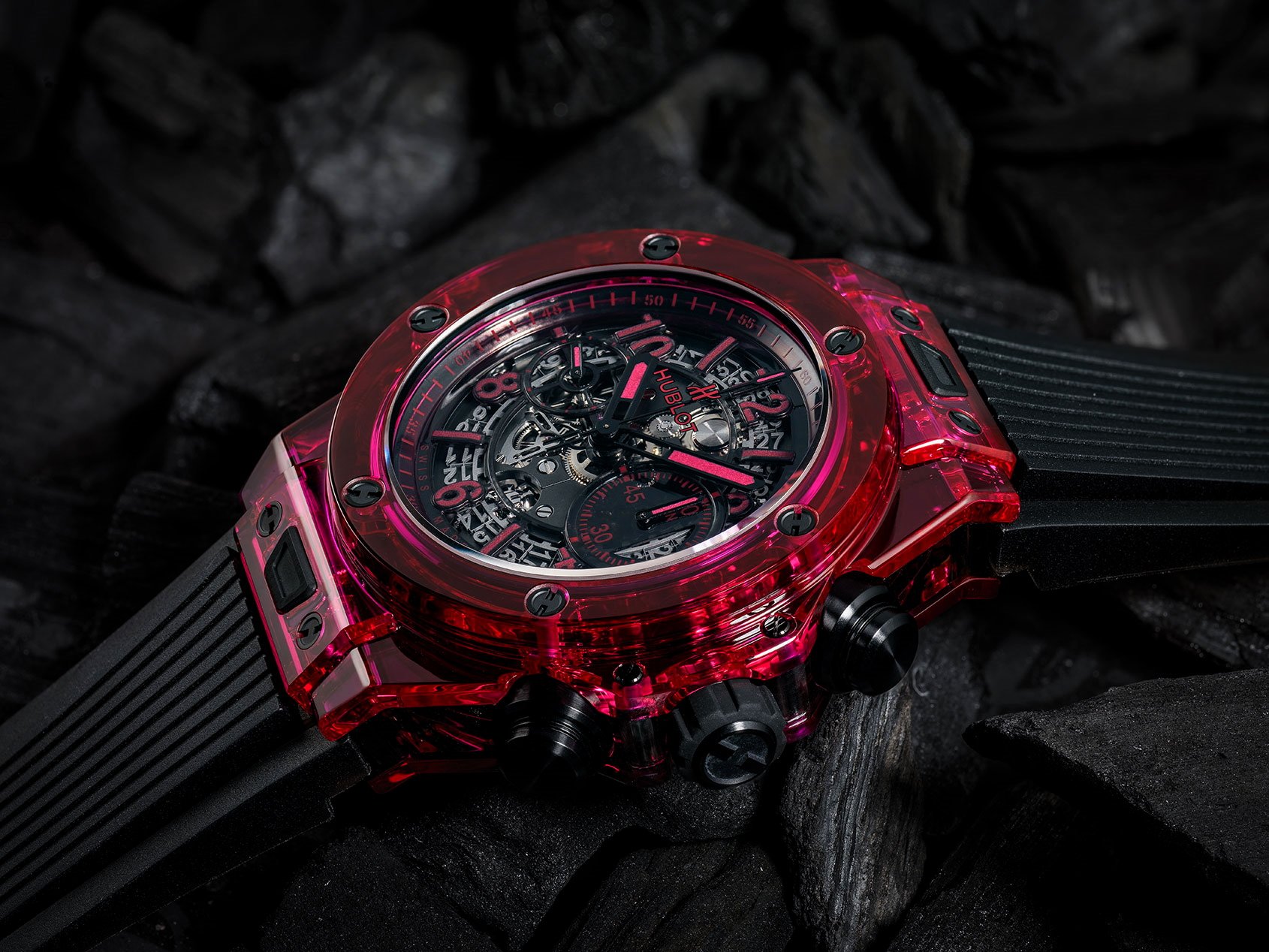
Case size: 45mm
Sapphire Colour: Blue Sapphire & Red Sapphire (Ruby)
Movement: Hublot Calibre HUB1242
Reference: 411.JL.4809.RT (Blue Sapphire), 411.JR.4901.RT (Red Sapphire)
2017 – Hublot Spirit of Big Bang Sapphire
Case size: 45mm
Sapphire Colour: Transparent
Movement: HUB4700
Reference: 601.JX.0120.RT
2017 – Hublot MP-07 Sapphire 40 Days Power Reserve
Case size: 51mm x 24mm
Sapphire Colour: Transparent
Movement: HUB9007.H1.PN calibre
Reference: 907.JX.0002.RT.HGL17
2017 – Hublot Big Bang Unico Sapphire Baguettes
Case size: 45mm
Sapphire Colour: Transparent
Movement: Hublot Calibre HUB1242
Reference: 411.JX.4802.RT.1904
2017 – Hublot Big Bang Unico Sapphire Usain Bolt (Only Watch 2017)
Case size: 45mm
Sapphire Colour: Transparent with 18k gold chronograph pushers and crown. 18k Screws on sapphire bezel.
Movement: Hublot Calibre HUB1242
2017 – Hublot Big Bang Unico All Black Sapphire Rainbow
Case size: 45mm
Sapphire Colour: Smoked black
Movement: Hublot Calibre HUB1242
2018 – Hublot Big Bang MP-11 Sapphire
Case size: 45mm
Sapphire Colour: Transparent
Movement: HUB9011 Manufacture Manual-winding
Reference: 911.JX.0102.RW
For More Information: Hublot.com.au
2019 – Hublot MP-11 SAXEM Green Sapphire
Case size: 45mm
Sapphire Colour: Green SAXEM
Movement: HUB9011 Manufacture Manual-winding
Reference: 911.JG.0129.RX
For More Information: Hublot.com.au
2020 – Hublot Big Bang Integral Tourbillon Full Sapphire
Case size: 43mm
Sapphire Colour: Transparent
Movement: Hublot In-house HUB6035
Reference: 455.JX.0120.JX
2021 – Hublot Classic Fusion Takashi Murakami Sapphire Rainbow
Case size: 45mm
Sapphire Colour: Transparent
Movement: HUB1214 UNICO Manufacture Self-winding Movement
Reference: 507.JX.0800.RT.TAK21
For More Information: Hublot.com.au
2021 – Hublot Big Bang Tourbillon Automatic Orange Sapphire
Case size: 45mm
Sapphire Colour: Orange
Movement: HUB6035 Manufacture Automatic Tourbillon Movement
Reference: 419.JO.0120.RT
For More Information: Hublot.com.au
2022 – Hublot Big Bang Tourbillon Automatic Purple Sapphire
Case size: 44mm
Sapphire Colour: Purple
Movement: HUB6035 Manufacture Movement
Reference: 429.JM.0120.RT
Related Reading: Hublot Big Bang Tourbillon Automatic Purple Sapphire
2023 – Hublot MP-15 Takashi Murakami Sapphire
Case size: 42mm
Sapphire Colour: Transparent
Movement: HUB9015 Manual-Winding Tourbillon
Reference: 915.JX.4802.RT
For More Information: Hublot.com.au
2023 – Hublot Square Bang Unico Sapphire
Case size: 42mm
Sapphire Colour: Transparent
Movement: HUB1280 UNICO Manufacture Self-winding Chronograph Flyback Movement
Reference: 821.JX.0120.RT
For More Information: Hublot.com.au
2023 – Hublot Big Bang Tourbillon Automatic Neon Yellow SAXEM
Case size: 44mm
Sapphire Colour: Yellow Neon SAXEM
Movement: HUB6035 Manufacture Automatic Tourbillon Movement
Reference: 429.JY.0120.RT
For More Information: Hublot.com.au
2023 – Hublot Big Bang Integrated Tourbillon Full Blue Sapphire
Case size: 43mm
Sapphire Colour: Blue
Movement: HUB6035 Manufacture Automatic Tourbillon Movement
Reference: 455.JL.0120.JL
For More Information: Hublot.com.au
2024 – Hublot Big Bang Unico Green SAXEM
Case size: 42mm
Sapphire Colour: Green SAXEM
Movement: HUB1280 UNICO Manufacture Self-winding Chronograph Flyback Movement
Reference: 441.JG.4990.RT
For More Information: Hublot.com.au
2024 – Hublot Big Bang MP-11 Water Blue Sapphire
Case size: 45mm
Sapphire Colour: Water Blue
Movement: HUB9011 Manufacture Manual-winding Skeleton Power Reserve Movement
Reference: 911.JL.0129.RX
For More Information: Hublot.com.au
2024 – Hublot Spirit of Big Bang Sang Bleu Sapphire
Case size: 42mm
Sapphire Colour: Transparent
Movement: HUB4700 Self-winding Skeleton Chronograph Movement
Reference: 648.JX.0102.RT.MXM24
For More Information: Hublot.com.au
The Future of Sapphire In Watchmaking
The future of sapphire in the world of horology is incredibly promising, especially considering that with more and more advancements in technology will mean that the potential of sapphire creations will be more refined. The complexity of creating sapphire watches along with the time and cost involved to do so gives the material limited use. We have seen that Hublot have been able to push well past these boundaries compared to other luxury brands. Even for Hublot, however, emerging innovations will pave the way for more efficient and sustainable methods in creating these incredible and unique timepieces.
Hublot’s research and development team have mastered the “Art of Fusion”. Their continuous development of coloured sapphire synthesis with colours like vibrant blue, red, yellow, purple, SAXEM green, water blue and even black is a testament to the brand’s commitment to expanding the potential of this spectacular material in the world of watchmaking. The future of the sapphire watchmaking of Hublot may include more intricate sapphire creations, including the brand’s MP collection, possibly even multicoloured gradients (bezel different sapphire colour?), and even combining sapphire with other cutting-edge materials!
What is undoubtedly clear is that Hublot is the leader in sapphire innovation. However, creating something new and different like this provokes resistance, as it challenges the comfort of tradition and the norms of an established industry. Hublot’s journey with Sapphire and many of their other “Art of Fusion” creations is a testament to this truth. The brand’s avant-garde designs have always been met with mixed reactions, as we can see through social media, and that’s okay. This willingness to keep pushing to innovate and embrace the uncharted drives progress. Through these bold, controversial moves, industries evolve, offering a glimpse of possibilities that redefine what is considered achievable.


